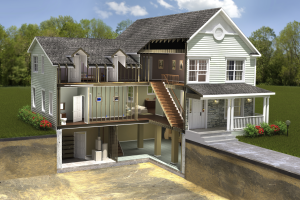Creating a home foundation in Michigan, as in many other regions, involves a series of steps tailored to the local climate, soil conditions, and building codes. Michigan’s diverse geography, ranging from sandy soils along the coastlines of the Great Lakes to clay and loam soils inland, necessitates a thoughtful approach to foundation building. The process typically involves the following key steps:
1. Site Evaluation and Preparation
Before any construction begins, a thorough evaluation of the building site is conducted. This includes soil testing to determine the soil type, bearing capacity, and the presence of the water table. Michigan’s colder climate also requires consideration of frost lines—the depth to which the ground freezes during winter—as this affects how deep the foundation must be to avoid frost heave.
2. Choosing the Right Type of Foundation
The type of foundation selected depends on the soil conditions, the size and design of the home, and budgetary constraints. The most common types of foundations in Michigan include:
- Basement Foundations: Popular in Michigan, especially in areas with colder climates, because they allow for additional living or storage space below ground. Basements must be constructed below the frost line to prevent damage from frost heave.
- Crawl Space Foundations: Elevated a few feet off the ground, crawl spaces offer a compromise between slab-on-grade and full basement foundations. They provide access to utilities and are built above the frost line but must be properly insulated and ventilated to prevent moisture issues.
- Slab-on-Grade Foundations: Less common in colder climates like Michigan’s but used in some modern or energy-efficient designs. These foundations consist of a concrete slab poured directly on the ground and can include integrated heating systems to prevent freezing.
3. Excavation and Footings
Once the foundation type is chosen, the site is excavated to the appropriate depth, considering the frost line and the foundation type. Footings, which are wider than the foundation walls and made of poured concrete, are installed to distribute the weight of the home evenly across the soil.
4. Pouring the Foundation
For basement and crawl space foundations, concrete walls are then poured into forms erected on the footings. In slab-on-grade foundations, a single pour creates the footing and the slab. The concrete must be properly cured, a process that takes several days and ensures the foundation’s strength and durability.
5. Waterproofing and Drainage
Given Michigan’s wet climate and the potential for heavy snowmelt, waterproofing the foundation is crucial to prevent water intrusion. This typically involves applying a waterproof membrane to the exterior of the foundation walls, installing a perimeter drain system to redirect water away from the foundation, and ensuring proper grading of the surrounding land.
6. Final Inspection and Backfill
After the foundation is poured and waterproofed, it must pass inspection by local building authorities to ensure it meets all building codes and standards. Once approved, the area around the foundation is backfilled with soil, and construction on the home can proceed.
Building a home foundation in Michigan requires careful planning and adherence to local building codes to ensure the structure’s long-term stability and safety. Properly constructed foundations account for the unique challenges posed by the state’s climate and soil conditions, providing a solid base for the construction of a durable and comfortable home.
 Do you have cracks or bowing in your basement foundation walls? The foundation repair experts at SAS Services, Inc. can help.
Do you have cracks or bowing in your basement foundation walls? The foundation repair experts at SAS Services, Inc. can help.



